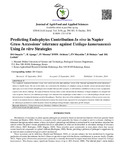| dc.contributor.author | Omayi, DO | |
| dc.contributor.author | Ajanga, SI | |
| dc.contributor.author | Muoma, JV | |
| dc.contributor.author | Ochieno, DMW. | |
| dc.contributor.author | Muyekho, FN | |
| dc.contributor.author | Mukoye, B | |
| dc.contributor.author | Leitich, RK | |
| dc.date.accessioned | 2023-10-11T14:34:46Z | |
| dc.date.available | 2023-10-11T14:34:46Z | |
| dc.date.issued | 2014-10-31 | |
| dc.identifier.uri | http://ir-library.mmust.ac.ke:8080/xmlui/handle/123456789/2362 | |
| dc.description.abstract | Mechanisms of resistance in plants against pathogens are primarily based on internal mechanisms which are genome based
(Freeman and Beattie, 2008). However, a scenario exists where generally the fitness of a plant to survive a disease challenge is
enhanced through secondary means; where a host plant’s physiology and defense is restructured by some harmless microbes that
survive within the plant’s tissues popularly known as endophytes in what can be described as secondary strategy of tolerance
(SST) (Herre, 2007; Rodriguez, 2009; Higgins, 2010). These microbes grow systemically in most plants where they secrete
certain beneficial compounds to a plant’s defense (Rodriguez, 2009). Hence, providing a pathway of pathogen’s suppression by
an infected plant in natural biological control mechanism.
These secretions can be inhibitory (Rachid and Mohamed, 2010), or can just enhance the host metabolism by triggering
production of auxins that enhance the host’s fitness in growth to cope with the disease establishment in poaceae family (Tanaka,
2012). Napier grass (Pennisetum purpureum) a poaceae is currently threatened by napier head smut disease caused by Ustilago
kamerunensis. This disease causes significant biomass losses of up to 46% (Farrell, 2000). The infected plant’s stems harden and produce smutted premature flower, becoming thin and grassy. The subsequent regrowth is smaller and total dry matter of
the affected crop reduces massively leading to reduced herbage yield (Farrell, 2002; Mwendia, 2007).
Therefore, to mitigate this disease challenge effectively through host plant resistance and biological control tactics there has
been a need to identify if a possible secondary strategy of tolerance (SST) is involved by the accessions to the disease and
possibility of head smut pathogen’s antagonists existence for breeding and bio- prospecting purposes. Basing on this, the present
study was conducted to try establish the likely role played | en_US |
| dc.language.iso | en | en_US |
| dc.publisher | Journal of Agri-Food and Applied Science | en_US |
| dc.subject | Predicting, Endophytes, Contribution, vivo,Napier, Grass, Accessions’ ,tolerance, against, Ustilago, kamerunensis, Using, vitro, Strategies | en_US |
| dc.title | Predicting Endophytes Contribution In vivo in Napier Grass Accessions’ tolerance against Ustilago kamerunensis Using In vitro Strategies | en_US |
| dc.type | Article | en_US |

